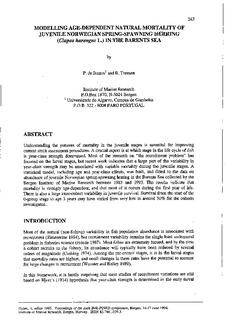| dc.contributor.author | Barros, P. de | |
| dc.contributor.author | Toresen, Reidar | |
| dc.date.accessioned | 2008-07-21T07:00:38Z | |
| dc.date.issued | 1995 | |
| dc.identifier.uri | http://hdl.handle.net/11250/107539 | |
| dc.description | Precision and relevance of pre-recruit studies for fishery management related to fish stocks in the Barents Sea and adjacent waters. Proceeding of the sixth IMR-PINRO Symposium Bergen, 14-17 June 1994 | en |
| dc.description.abstract | Understanding the patterns of mortality in the juvenile stages is essential for improving
current stock assessment procedures. A crucial aspect is at which stage in the life cycle of fish
is year-class strength determined. Most of the research on "the recruitment problem" has
focused on the larval stages, but recent work indicates that a large part of the variability in
year-class strength may be associated with variable mortality during the juvenile stages. A
statistical model, including age and year-class effects, was built, and fitted to the data on
abundance of juvenile Norwegian spring-spawning herring in the Barents Sea collected by the
Bergen Institute of Marine Research between 1983 and 1993. The results indicate that
mortality is strongly age-dependent, and that most of it occurs during the first year of life.
There is also a large inter-cohort variability in juvenile survival. Survival from the start of the
O-group stage to age 3 years may have varied from very low to around 30% for the cohorts
investigated. | en |
| dc.format.extent | 892789 bytes | |
| dc.format.mimetype | application/pdf | |
| dc.language.iso | eng | en |
| dc.relation.ispartofseries | PINRO-IMR Symposium | en |
| dc.relation.ispartofseries | 6 | en |
| dc.title | Modelling age-dependent natural mortality of juvenile Norwegian spring-spawning herring (Clupea harengus L.) in the Barents Sea | en |
| dc.type | Conference object | en |
| dc.subject.nsi | VDP::Agriculture and fishery disciplines: 900::Fisheries science: 920 | en |
| dc.source.pagenumber | s. 243-261 | |
